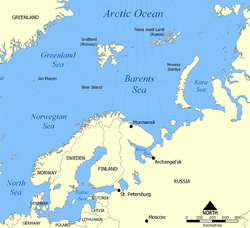| Convoy QP.15 | |||||||
|---|---|---|---|---|---|---|---|
| Part of Second World War | |||||||
 The Norwegian and the Barents seas, site of the Arctic convoys | |||||||
| |||||||
| Belligerents | |||||||
| | | ||||||
| Commanders and leaders | |||||||
| Karl Dönitz | Convoy commodore: W. C. Meek | ||||||
| Strength | |||||||
|
| ||||||
| Casualties and losses | |||||||
| |||||||
Convoy QP 15 was one of the Arctic convoys of World War II the last of the QP series from northern Russia to Britain which ran during the Second World War to return Allied ships to home ports. The convoy sailed from the Kola Inlet on 17 November 1942. It was scattered by a storm in which the Soviet destroyer Sokrushitelny was hit from behind by a big wave and foundered after two days' rescue attempts. The convoy was attacked by U-boats of the Kriegsmarine (German Navy) that sank two of the merchant ships. The convoy reached its destination at Loch Ewe on 30 November 1942.